Comprehensive Analysis of Aboriginal Policy in NSW: A Critical Review
VerifiedAdded on 2021/05/31
|6
|1211
|39
Report
AI Summary
This report provides a comprehensive analysis of Aboriginal policies in New South Wales (NSW), Australia. It begins with an introduction to the Aboriginal population in NSW and their cultural contributions. The core of the report discusses current policies related to education, workplace, and health, highlighting the Aboriginal Medical Service, the Aboriginal Land Right Act, and the REM framework (Respect, Engagement, and sharing and Moving forward together). The report presents evidence, including statistical data on Aboriginal population, employment growth, and health indicators. It critically evaluates the strengths and weaknesses of these policies, such as the emphasis on respect and cultural understanding versus challenges like health disparities and inadequate support for rural health clinics. Finally, the report offers recommendations for improving policy implementation, including stronger monitoring systems, collaboration between government and NGOs, and awareness campaigns for non-indigenous people. The conclusion emphasizes the importance of effective monitoring and preservation of Aboriginal cultural properties.
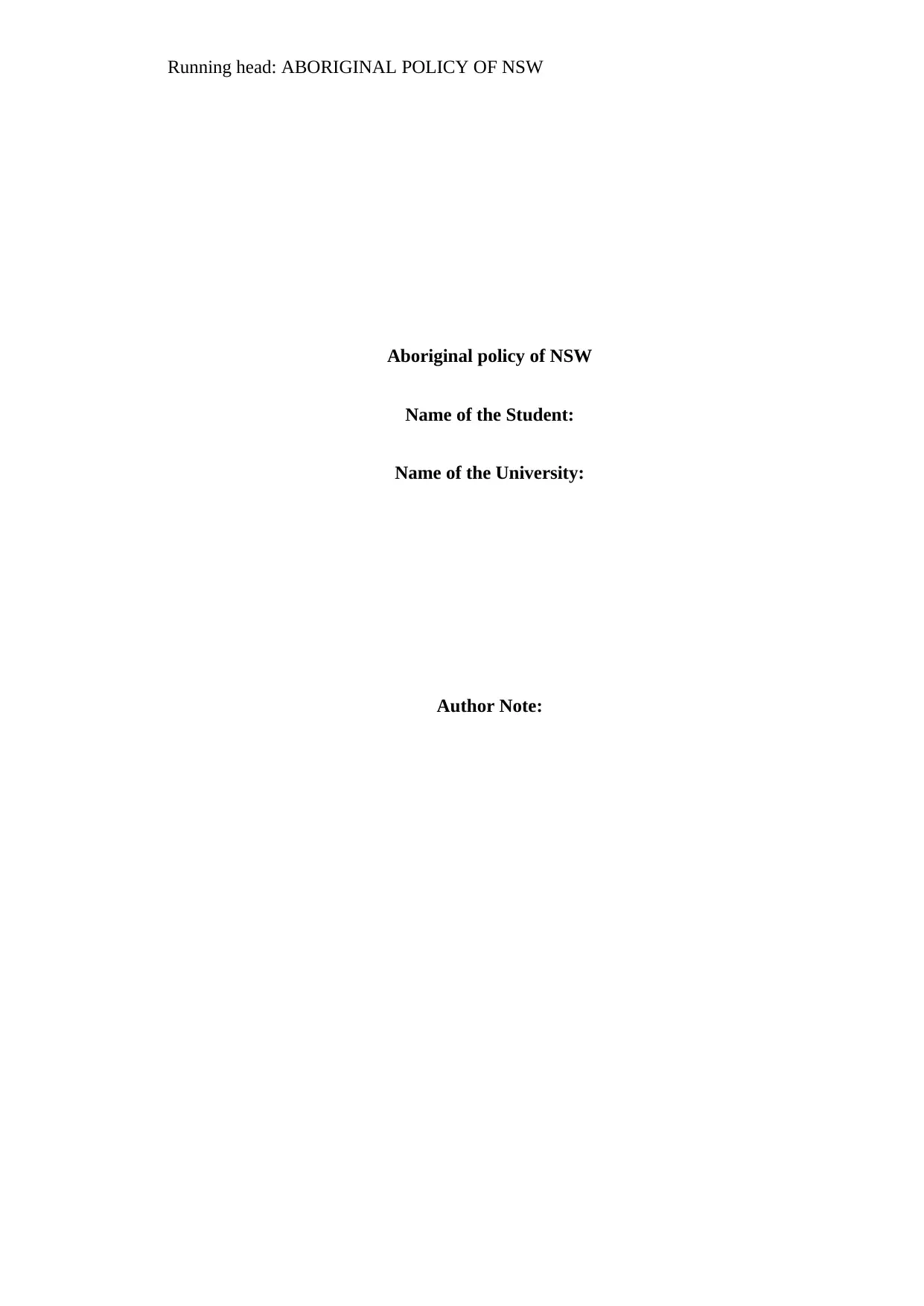
Running head: ABORIGINAL POLICY OF NSW
Aboriginal policy of NSW
Name of the Student:
Name of the University:
Author Note:
Aboriginal policy of NSW
Name of the Student:
Name of the University:
Author Note:
Paraphrase This Document
Need a fresh take? Get an instant paraphrase of this document with our AI Paraphraser
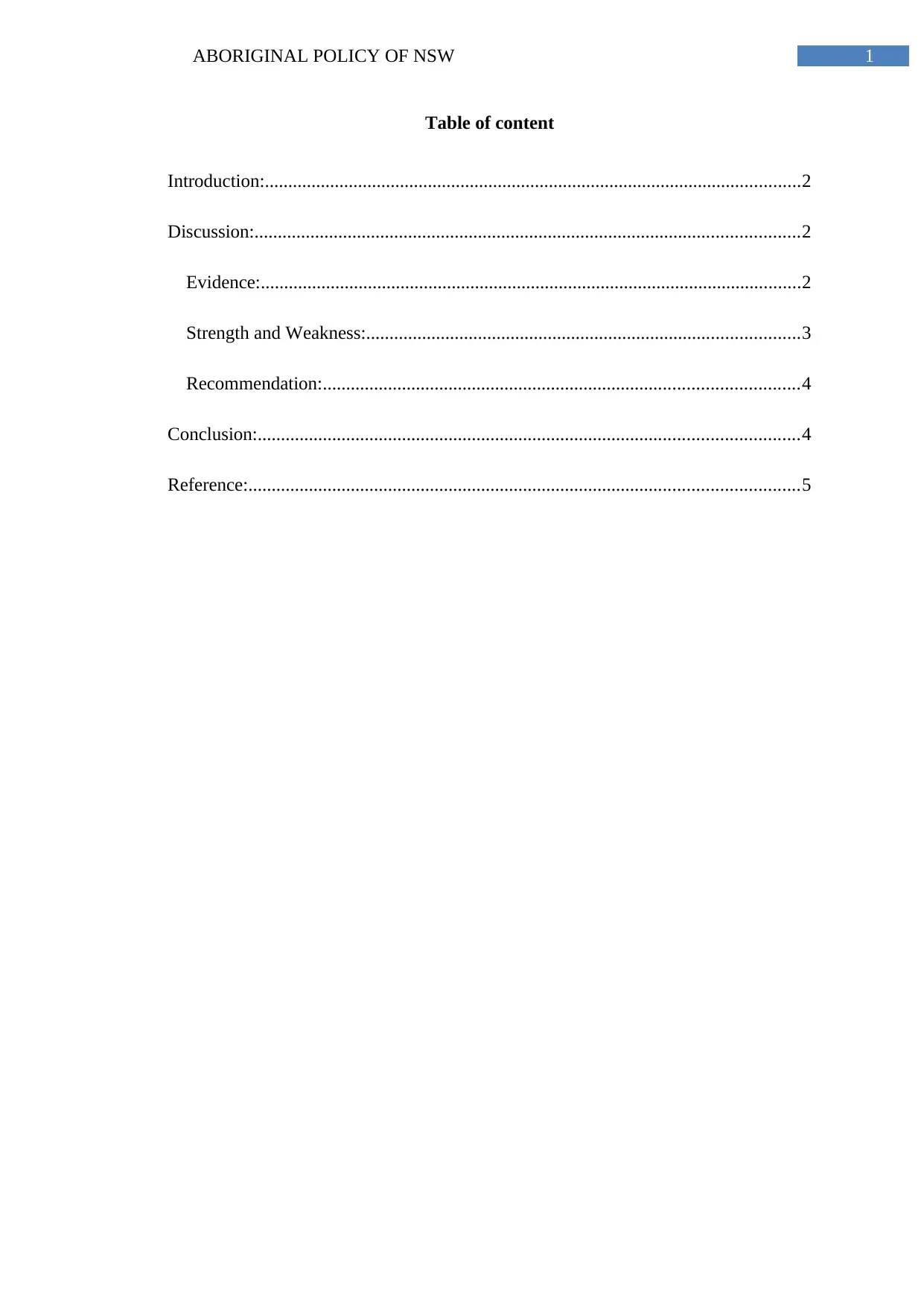
1ABORIGINAL POLICY OF NSW
Table of content
Introduction:...................................................................................................................2
Discussion:.....................................................................................................................2
Evidence:....................................................................................................................2
Strength and Weakness:.............................................................................................3
Recommendation:......................................................................................................4
Conclusion:....................................................................................................................4
Reference:......................................................................................................................5
Table of content
Introduction:...................................................................................................................2
Discussion:.....................................................................................................................2
Evidence:....................................................................................................................2
Strength and Weakness:.............................................................................................3
Recommendation:......................................................................................................4
Conclusion:....................................................................................................................4
Reference:......................................................................................................................5
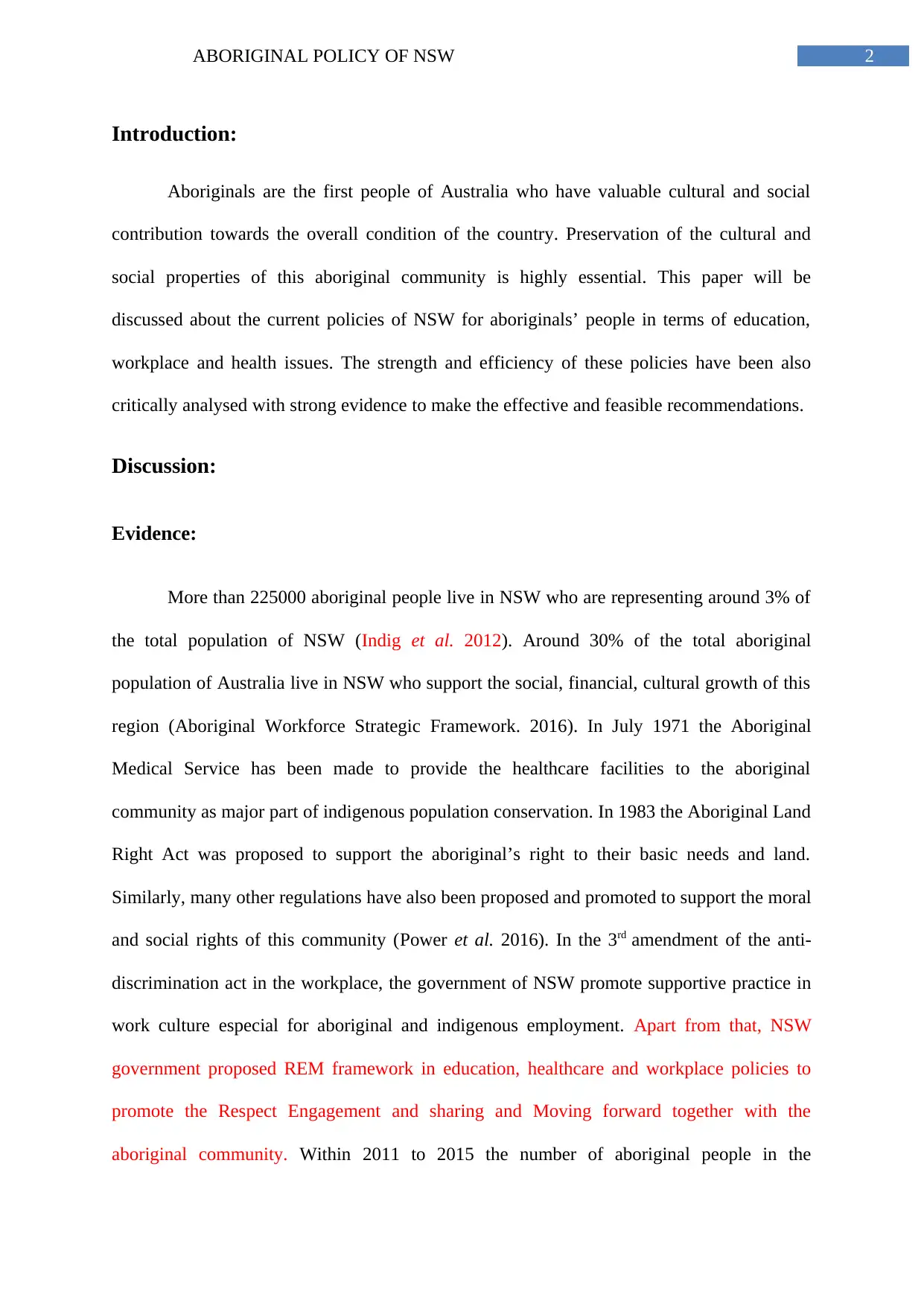
2ABORIGINAL POLICY OF NSW
Introduction:
Aboriginals are the first people of Australia who have valuable cultural and social
contribution towards the overall condition of the country. Preservation of the cultural and
social properties of this aboriginal community is highly essential. This paper will be
discussed about the current policies of NSW for aboriginals’ people in terms of education,
workplace and health issues. The strength and efficiency of these policies have been also
critically analysed with strong evidence to make the effective and feasible recommendations.
Discussion:
Evidence:
More than 225000 aboriginal people live in NSW who are representing around 3% of
the total population of NSW (Indig et al. 2012). Around 30% of the total aboriginal
population of Australia live in NSW who support the social, financial, cultural growth of this
region (Aboriginal Workforce Strategic Framework. 2016). In July 1971 the Aboriginal
Medical Service has been made to provide the healthcare facilities to the aboriginal
community as major part of indigenous population conservation. In 1983 the Aboriginal Land
Right Act was proposed to support the aboriginal’s right to their basic needs and land.
Similarly, many other regulations have also been proposed and promoted to support the moral
and social rights of this community (Power et al. 2016). In the 3rd amendment of the anti-
discrimination act in the workplace, the government of NSW promote supportive practice in
work culture especial for aboriginal and indigenous employment. Apart from that, NSW
government proposed REM framework in education, healthcare and workplace policies to
promote the Respect Engagement and sharing and Moving forward together with the
aboriginal community. Within 2011 to 2015 the number of aboriginal people in the
Introduction:
Aboriginals are the first people of Australia who have valuable cultural and social
contribution towards the overall condition of the country. Preservation of the cultural and
social properties of this aboriginal community is highly essential. This paper will be
discussed about the current policies of NSW for aboriginals’ people in terms of education,
workplace and health issues. The strength and efficiency of these policies have been also
critically analysed with strong evidence to make the effective and feasible recommendations.
Discussion:
Evidence:
More than 225000 aboriginal people live in NSW who are representing around 3% of
the total population of NSW (Indig et al. 2012). Around 30% of the total aboriginal
population of Australia live in NSW who support the social, financial, cultural growth of this
region (Aboriginal Workforce Strategic Framework. 2016). In July 1971 the Aboriginal
Medical Service has been made to provide the healthcare facilities to the aboriginal
community as major part of indigenous population conservation. In 1983 the Aboriginal Land
Right Act was proposed to support the aboriginal’s right to their basic needs and land.
Similarly, many other regulations have also been proposed and promoted to support the moral
and social rights of this community (Power et al. 2016). In the 3rd amendment of the anti-
discrimination act in the workplace, the government of NSW promote supportive practice in
work culture especial for aboriginal and indigenous employment. Apart from that, NSW
government proposed REM framework in education, healthcare and workplace policies to
promote the Respect Engagement and sharing and Moving forward together with the
aboriginal community. Within 2011 to 2015 the number of aboriginal people in the
⊘ This is a preview!⊘
Do you want full access?
Subscribe today to unlock all pages.

Trusted by 1+ million students worldwide
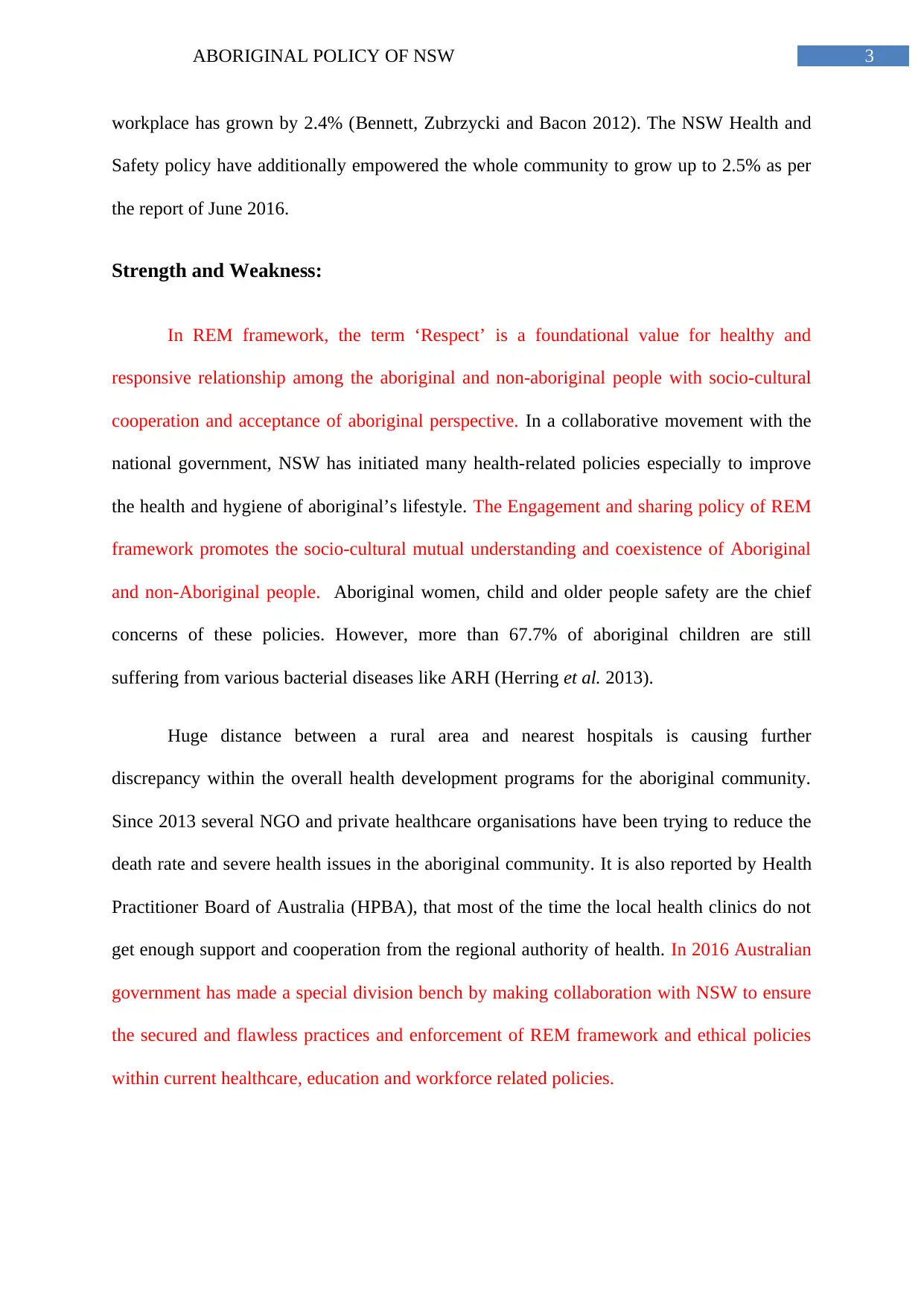
3ABORIGINAL POLICY OF NSW
workplace has grown by 2.4% (Bennett, Zubrzycki and Bacon 2012). The NSW Health and
Safety policy have additionally empowered the whole community to grow up to 2.5% as per
the report of June 2016.
Strength and Weakness:
In REM framework, the term ‘Respect’ is a foundational value for healthy and
responsive relationship among the aboriginal and non-aboriginal people with socio-cultural
cooperation and acceptance of aboriginal perspective. In a collaborative movement with the
national government, NSW has initiated many health-related policies especially to improve
the health and hygiene of aboriginal’s lifestyle. The Engagement and sharing policy of REM
framework promotes the socio-cultural mutual understanding and coexistence of Aboriginal
and non-Aboriginal people. Aboriginal women, child and older people safety are the chief
concerns of these policies. However, more than 67.7% of aboriginal children are still
suffering from various bacterial diseases like ARH (Herring et al. 2013).
Huge distance between a rural area and nearest hospitals is causing further
discrepancy within the overall health development programs for the aboriginal community.
Since 2013 several NGO and private healthcare organisations have been trying to reduce the
death rate and severe health issues in the aboriginal community. It is also reported by Health
Practitioner Board of Australia (HPBA), that most of the time the local health clinics do not
get enough support and cooperation from the regional authority of health. In 2016 Australian
government has made a special division bench by making collaboration with NSW to ensure
the secured and flawless practices and enforcement of REM framework and ethical policies
within current healthcare, education and workforce related policies.
workplace has grown by 2.4% (Bennett, Zubrzycki and Bacon 2012). The NSW Health and
Safety policy have additionally empowered the whole community to grow up to 2.5% as per
the report of June 2016.
Strength and Weakness:
In REM framework, the term ‘Respect’ is a foundational value for healthy and
responsive relationship among the aboriginal and non-aboriginal people with socio-cultural
cooperation and acceptance of aboriginal perspective. In a collaborative movement with the
national government, NSW has initiated many health-related policies especially to improve
the health and hygiene of aboriginal’s lifestyle. The Engagement and sharing policy of REM
framework promotes the socio-cultural mutual understanding and coexistence of Aboriginal
and non-Aboriginal people. Aboriginal women, child and older people safety are the chief
concerns of these policies. However, more than 67.7% of aboriginal children are still
suffering from various bacterial diseases like ARH (Herring et al. 2013).
Huge distance between a rural area and nearest hospitals is causing further
discrepancy within the overall health development programs for the aboriginal community.
Since 2013 several NGO and private healthcare organisations have been trying to reduce the
death rate and severe health issues in the aboriginal community. It is also reported by Health
Practitioner Board of Australia (HPBA), that most of the time the local health clinics do not
get enough support and cooperation from the regional authority of health. In 2016 Australian
government has made a special division bench by making collaboration with NSW to ensure
the secured and flawless practices and enforcement of REM framework and ethical policies
within current healthcare, education and workforce related policies.
Paraphrase This Document
Need a fresh take? Get an instant paraphrase of this document with our AI Paraphraser
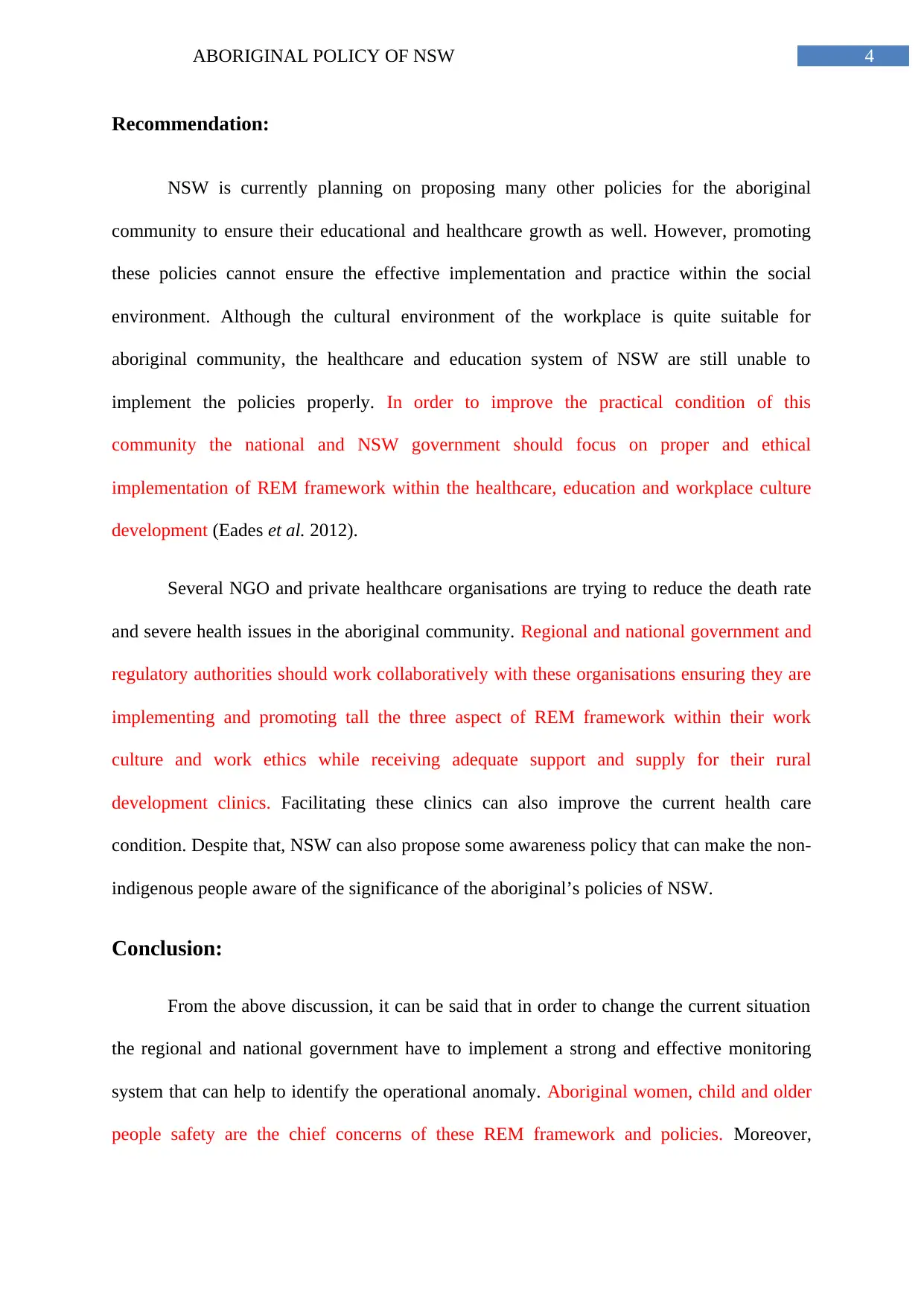
4ABORIGINAL POLICY OF NSW
Recommendation:
NSW is currently planning on proposing many other policies for the aboriginal
community to ensure their educational and healthcare growth as well. However, promoting
these policies cannot ensure the effective implementation and practice within the social
environment. Although the cultural environment of the workplace is quite suitable for
aboriginal community, the healthcare and education system of NSW are still unable to
implement the policies properly. In order to improve the practical condition of this
community the national and NSW government should focus on proper and ethical
implementation of REM framework within the healthcare, education and workplace culture
development (Eades et al. 2012).
Several NGO and private healthcare organisations are trying to reduce the death rate
and severe health issues in the aboriginal community. Regional and national government and
regulatory authorities should work collaboratively with these organisations ensuring they are
implementing and promoting tall the three aspect of REM framework within their work
culture and work ethics while receiving adequate support and supply for their rural
development clinics. Facilitating these clinics can also improve the current health care
condition. Despite that, NSW can also propose some awareness policy that can make the non-
indigenous people aware of the significance of the aboriginal’s policies of NSW.
Conclusion:
From the above discussion, it can be said that in order to change the current situation
the regional and national government have to implement a strong and effective monitoring
system that can help to identify the operational anomaly. Aboriginal women, child and older
people safety are the chief concerns of these REM framework and policies. Moreover,
Recommendation:
NSW is currently planning on proposing many other policies for the aboriginal
community to ensure their educational and healthcare growth as well. However, promoting
these policies cannot ensure the effective implementation and practice within the social
environment. Although the cultural environment of the workplace is quite suitable for
aboriginal community, the healthcare and education system of NSW are still unable to
implement the policies properly. In order to improve the practical condition of this
community the national and NSW government should focus on proper and ethical
implementation of REM framework within the healthcare, education and workplace culture
development (Eades et al. 2012).
Several NGO and private healthcare organisations are trying to reduce the death rate
and severe health issues in the aboriginal community. Regional and national government and
regulatory authorities should work collaboratively with these organisations ensuring they are
implementing and promoting tall the three aspect of REM framework within their work
culture and work ethics while receiving adequate support and supply for their rural
development clinics. Facilitating these clinics can also improve the current health care
condition. Despite that, NSW can also propose some awareness policy that can make the non-
indigenous people aware of the significance of the aboriginal’s policies of NSW.
Conclusion:
From the above discussion, it can be said that in order to change the current situation
the regional and national government have to implement a strong and effective monitoring
system that can help to identify the operational anomaly. Aboriginal women, child and older
people safety are the chief concerns of these REM framework and policies. Moreover,
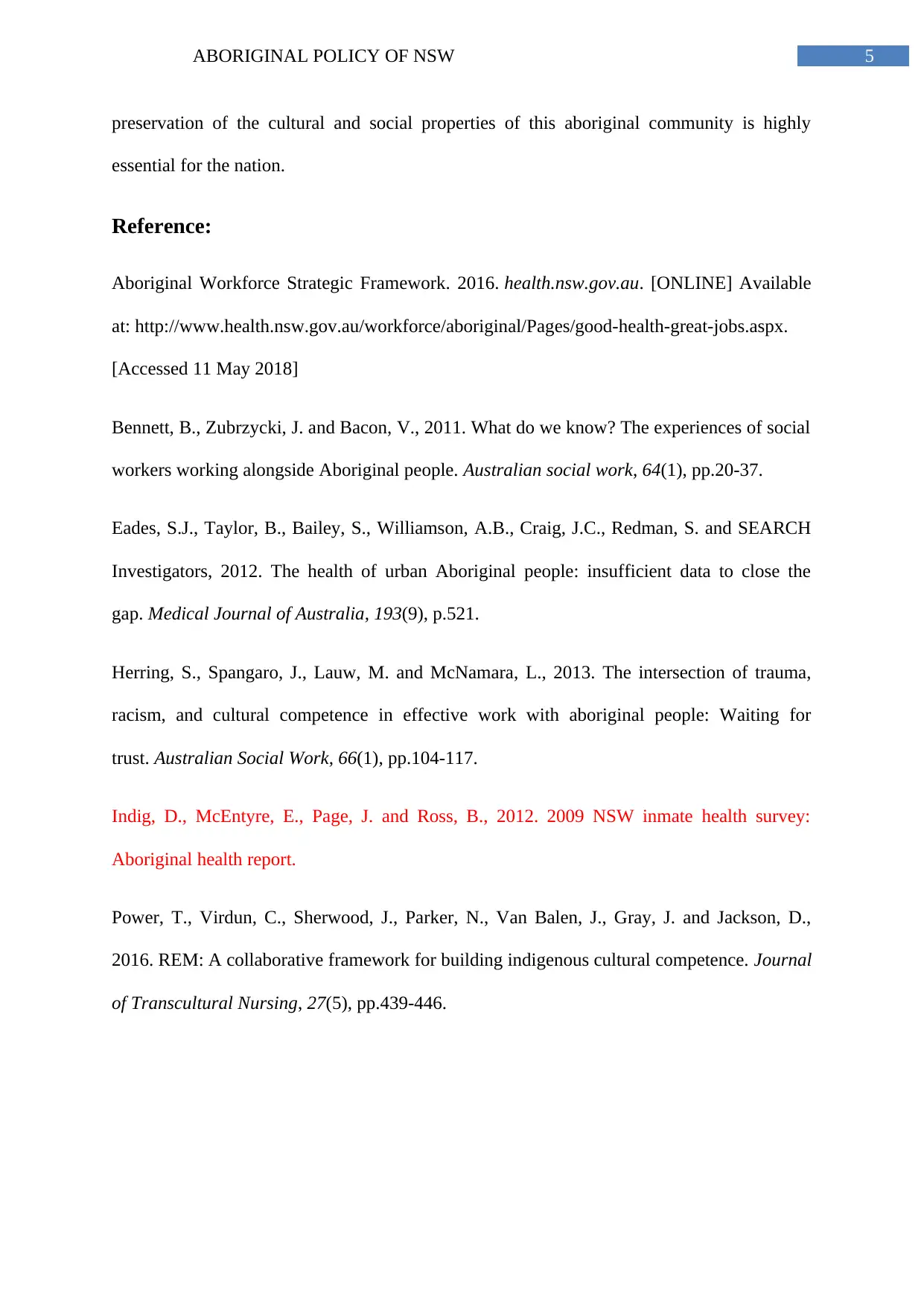
5ABORIGINAL POLICY OF NSW
preservation of the cultural and social properties of this aboriginal community is highly
essential for the nation.
Reference:
Aboriginal Workforce Strategic Framework. 2016. health.nsw.gov.au. [ONLINE] Available
at: http://www.health.nsw.gov.au/workforce/aboriginal/Pages/good-health-great-jobs.aspx.
[Accessed 11 May 2018]
Bennett, B., Zubrzycki, J. and Bacon, V., 2011. What do we know? The experiences of social
workers working alongside Aboriginal people. Australian social work, 64(1), pp.20-37.
Eades, S.J., Taylor, B., Bailey, S., Williamson, A.B., Craig, J.C., Redman, S. and SEARCH
Investigators, 2012. The health of urban Aboriginal people: insufficient data to close the
gap. Medical Journal of Australia, 193(9), p.521.
Herring, S., Spangaro, J., Lauw, M. and McNamara, L., 2013. The intersection of trauma,
racism, and cultural competence in effective work with aboriginal people: Waiting for
trust. Australian Social Work, 66(1), pp.104-117.
Indig, D., McEntyre, E., Page, J. and Ross, B., 2012. 2009 NSW inmate health survey:
Aboriginal health report.
Power, T., Virdun, C., Sherwood, J., Parker, N., Van Balen, J., Gray, J. and Jackson, D.,
2016. REM: A collaborative framework for building indigenous cultural competence. Journal
of Transcultural Nursing, 27(5), pp.439-446.
preservation of the cultural and social properties of this aboriginal community is highly
essential for the nation.
Reference:
Aboriginal Workforce Strategic Framework. 2016. health.nsw.gov.au. [ONLINE] Available
at: http://www.health.nsw.gov.au/workforce/aboriginal/Pages/good-health-great-jobs.aspx.
[Accessed 11 May 2018]
Bennett, B., Zubrzycki, J. and Bacon, V., 2011. What do we know? The experiences of social
workers working alongside Aboriginal people. Australian social work, 64(1), pp.20-37.
Eades, S.J., Taylor, B., Bailey, S., Williamson, A.B., Craig, J.C., Redman, S. and SEARCH
Investigators, 2012. The health of urban Aboriginal people: insufficient data to close the
gap. Medical Journal of Australia, 193(9), p.521.
Herring, S., Spangaro, J., Lauw, M. and McNamara, L., 2013. The intersection of trauma,
racism, and cultural competence in effective work with aboriginal people: Waiting for
trust. Australian Social Work, 66(1), pp.104-117.
Indig, D., McEntyre, E., Page, J. and Ross, B., 2012. 2009 NSW inmate health survey:
Aboriginal health report.
Power, T., Virdun, C., Sherwood, J., Parker, N., Van Balen, J., Gray, J. and Jackson, D.,
2016. REM: A collaborative framework for building indigenous cultural competence. Journal
of Transcultural Nursing, 27(5), pp.439-446.
⊘ This is a preview!⊘
Do you want full access?
Subscribe today to unlock all pages.

Trusted by 1+ million students worldwide
1 out of 6
Related Documents
Your All-in-One AI-Powered Toolkit for Academic Success.
+13062052269
info@desklib.com
Available 24*7 on WhatsApp / Email
![[object Object]](/_next/static/media/star-bottom.7253800d.svg)
Unlock your academic potential
Copyright © 2020–2025 A2Z Services. All Rights Reserved. Developed and managed by ZUCOL.





